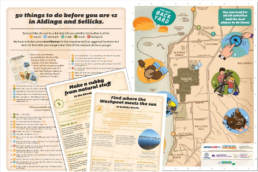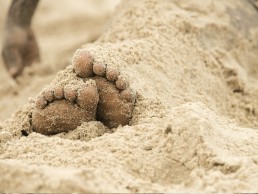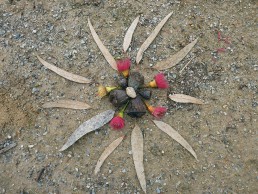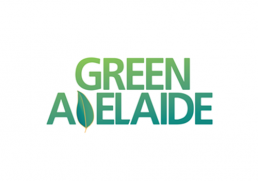Our Big Backyard Aldinga and Sellicks - South Australia

Our Big Backyard Aldinga Sellicks activity pack includes –
The Our Big Backyard map with a list of 60 local free outdoor activities and 20 local activity guides including Cubby building at Port Willunga, stick boats at Hart Road Wetland, pond dipping, reef walks, fossil hunts, beach combing and more.
Where can I pick up a free hard copy?
Printed maps and activity packs can be collected from Aldinga Library, Central Way Aldinga Beach (https://www.onkaparingacity.com/Around-me/Venues/Aldinga-Library)
What's New?
For latest updates, news and other up to date information, please visit out facebook page using the link below.
Aldinga and Sellicks Our Big Backyard 2014- present

Our Story
- More than 3500 activity packs distributed
- Hundreds on school children engaged in the project development
- National media interest
- SA Children’s week award
- Interstate and local interest in developing projects
- Lots of fun, engagement and exploring.
The Project Team
Diversity and a varied approach were the key strengths in developing Our Big Back Yard. We brought together a team that included people with experience in environmental education, early years learning, social services, local knowledge and family services. The diversity of key interests meant that no single agenda dominated the program and that all elements complemented and led into each other.
- The activities are informed by natural resources management (NRM) environmental knowledge and principles.
- Key developmental milestones and family play are woven in from the Aldinga Beach Children’s Centre.
- Focus on identity and local knowledge brought by City of Onkaparinga’s Neighbourhood Development.
- Local school children connected and engaged for feedback through Aldinga Beach Children’s Centre.
- Diverse locations identified through council’s Neighbourhood Development.


Consultation
The Aldinga and Sellicks Beach area has grown rapidly in recent years and the statistics suggest that a large proportion of the new population is from interstate, or country other than Australia, has young children and works outside the area.
When talking to parents in the area at schools and playgroups it became apparent that there was a strong interest in the local area but limited knowledge.
There was also a disconcerting amount of fear of risk for children, either in physical activity, exploration of new places or independent play.
We developed the project to focus on parents becoming motivated to share recreational, educational and emotional experiences with their children. The initial concept was to make a map and activity descriptions that would promote and simplify the exploration of local, key environmental assets with supported activities based on a “come and try” model.
If the project was successful then families would be knowledgeable about local culture and landscape, and have a strong shared memory of positive experiences in the Aldinga Sellicks area.
The Knowledge base
We conducted workshops with local primary school children to ask them to brainstorm ideas for the 50 things to do list and gained a great understanding of not only what they thought would be great, but also what was absent from the discussion.
We sought out opinions of other adults in the community about their memories of growing up locally and used these discussions to inform the final list. We felt it was essential to attach locations to as many activities as possible, not just create a generic activity list. The project was deliberately designed as an exercise in orientation, as much as activity.
Materials
We contracted a graphic design company who specialised in environmental communication, to develop the map and activity sheets as well as a set of collector cards representing the first twenty activities. Content was developed by the project group and tweaked by staff from Natural Resources Adelaide and Mount Lofty Ranges to confirm accuracy when describing specific animals and plants. Funding for this phase came from Communities for Children SA, City of Onkaparinga and The Aldinga Beach Children’s Centre.
Implementation
There was a deliberate focus on three key locations to obtain the maps, cards and activity sheets. We used social media to tell people to collect the materials on the local library and Aldinga Beach Children’s Centre with the intention of having families access these centres.
The delivery schedule followed activities on the list and included:
- Cubby building in the She-oak forest at Port Willunga
- Stick boats at Dover Street Wetland, Aldinga Beach
- Pond dipping at Hart Road Wetlands, Aldinga Beach
- Fossil Hunting at Perkana Point, Port Willunga
- Beach combing at Aldinga Reef
- Combined schools wetlands excursion at Hart Road Wetlands, Aldinga Beach.
When introducing the sites and activities we always started with a show of hands to see who had been to this place before, with an average of more than half and in some cases all but one indicating that they had not been to the site before. This is despite all sites being within walking distance of the Aldinga shopping centre in the middle of town.

Review
The project has been enormously popular with all printed material distributed and strong demand for more. The review phase included a redesign of the map and creation of further materials. The project group added further content with the intent to conduct bi-annual reviews as feedback is received from our children’s focus groups.
A range of other outcomes were developed through the promotion and rollout including:
- Out of school hours care (OSHC) providers are using the activity suggestions in their programming.
- Two local primary schools using the activity model to plan excursions, with more activities planned.
- Changes in policy – one local school has reintroduced tree climbing and sticks to the playground after removing all sticks previously as a safety measure. The active and creative play benefits of having natural loose objects has been recognised.
- An outdoor playgroup for under-fives has been established and will be supported by activities on the 50 things to do list.
- An ongoing conversation has developed around the benefits of natural play and how it can support a range of social outcomes in the area and interest continues.












